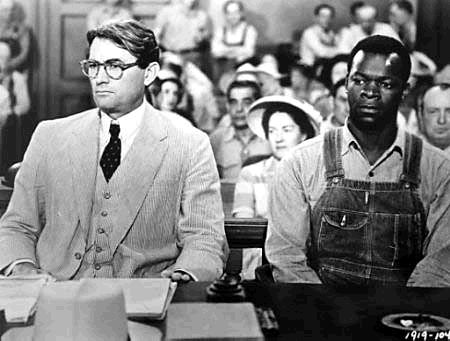
To Kill A Mocking Bird
Harper Lee's To Kill A Mocking Bird was released in the 1960's and the film was released just two short years after. The significance of this novel and film lie in the racist reflections of social attitudes in the United States during both the Post Civil War Era and early Civil Rights Era. This image reflects the message of the novel, and the film gives the audience the feel good attitude through the protagonist of a child who's objectivity, seems to be more important than the prosecution of an innocent man.
Paul Robinson has been accused of raping a white woman and his attorney, Atticus Finch, feels morally obligated to help this innocent black man, depicted through the lense of and as a child. This black man is depicted as a child in the sense, that he is fighting for rights in an adult world: The world of law and politics. He is depicted as someone deserving to be outside of this sphere of intellectuals because of his color.
Atticus Finch, on the other hand, is in his proper social position, as a prosperous white attorney, believes in justice but fails to prove Robinson innocent. This reflects some attitudes which circulated around cases such as the Scottsborro Trials. The audience was swayed into moral relief because both the child and the audience were made to feel that they had no connections to such injustices while also perpetuating a system which clearly favored injustice over black workers who threatened white supremacy.
Paul Robinson has been accused of raping a white woman and his attorney, Atticus Finch, feels morally obligated to help this innocent black man, depicted through the lense of and as a child. This black man is depicted as a child in the sense, that he is fighting for rights in an adult world: The world of law and politics. He is depicted as someone deserving to be outside of this sphere of intellectuals because of his color.
Atticus Finch, on the other hand, is in his proper social position, as a prosperous white attorney, believes in justice but fails to prove Robinson innocent. This reflects some attitudes which circulated around cases such as the Scottsborro Trials. The audience was swayed into moral relief because both the child and the audience were made to feel that they had no connections to such injustices while also perpetuating a system which clearly favored injustice over black workers who threatened white supremacy.

No comments:
Post a Comment